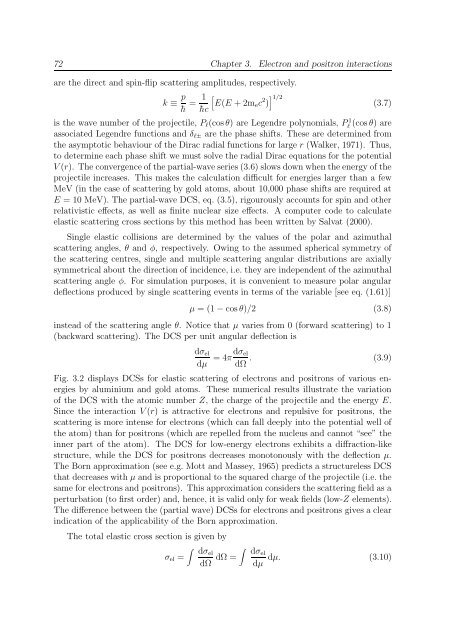PENELOPE 2003 - OECD Nuclear Energy Agency
PENELOPE 2003 - OECD Nuclear Energy Agency
PENELOPE 2003 - OECD Nuclear Energy Agency
Create successful ePaper yourself
Turn your PDF publications into a flip-book with our unique Google optimized e-Paper software.
72 Chapter 3. Electron and positron interactions<br />
are the direct and spin-flip scattering amplitudes, respectively.<br />
k ≡ p¯h = 1 [<br />
E(E + 2me c 2 ) ] 1/2<br />
¯hc<br />
(3.7)<br />
is the wave number of the projectile, P l (cos θ) are Legendre polynomials, Pl 1 (cos θ) are<br />
associated Legendre functions and δ l± are the phase shifts. These are determined from<br />
the asymptotic behaviour of the Dirac radial functions for large r (Walker, 1971). Thus,<br />
to determine each phase shift we must solve the radial Dirac equations for the potential<br />
V (r). The convergence of the partial-wave series (3.6) slows down when the energy of the<br />
projectile increases. This makes the calculation difficult for energies larger than a few<br />
MeV (in the case of scattering by gold atoms, about 10,000 phase shifts are required at<br />
E = 10 MeV). The partial-wave DCS, eq. (3.5), rigourously accounts for spin and other<br />
relativistic effects, as well as finite nuclear size effects. A computer code to calculate<br />
elastic scattering cross sections by this method has been written by Salvat (2000).<br />
Single elastic collisions are determined by the values of the polar and azimuthal<br />
scattering angles, θ and φ, respectively. Owing to the assumed spherical symmetry of<br />
the scattering centres, single and multiple scattering angular distributions are axially<br />
symmetrical about the direction of incidence, i.e. they are independent of the azimuthal<br />
scattering angle φ. For simulation purposes, it is convenient to measure polar angular<br />
deflections produced by single scattering events in terms of the variable [see eq. (1.61)]<br />
µ = (1 − cos θ)/2 (3.8)<br />
instead of the scattering angle θ. Notice that µ varies from 0 (forward scattering) to 1<br />
(backward scattering). The DCS per unit angular deflection is<br />
dσ el<br />
dµ = 4π dσ el<br />
dΩ . (3.9)<br />
Fig. 3.2 displays DCSs for elastic scattering of electrons and positrons of various energies<br />
by aluminium and gold atoms. These numerical results illustrate the variation<br />
of the DCS with the atomic number Z, the charge of the projectile and the energy E.<br />
Since the interaction V (r) is attractive for electrons and repulsive for positrons, the<br />
scattering is more intense for electrons (which can fall deeply into the potential well of<br />
the atom) than for positrons (which are repelled from the nucleus and cannot “see” the<br />
inner part of the atom). The DCS for low-energy electrons exhibits a diffraction-like<br />
structure, while the DCS for positrons decreases monotonously with the deflection µ.<br />
The Born approximation (see e.g. Mott and Massey, 1965) predicts a structureless DCS<br />
that decreases with µ and is proportional to the squared charge of the projectile (i.e. the<br />
same for electrons and positrons). This approximation considers the scattering field as a<br />
perturbation (to first order) and, hence, it is valid only for weak fields (low-Z elements).<br />
The difference between the (partial wave) DCSs for electrons and positrons gives a clear<br />
indication of the applicability of the Born approximation.<br />
The total elastic cross section is given by<br />
∫<br />
∫ dσel<br />
σ el =<br />
dΩ dΩ =<br />
dσel<br />
dµ<br />
dµ. (3.10)
















